The Product of Lenny: How product strategy fundamentals created a one-person, million-dollar business

Learning from Lenny Rachitsky is frustrating. I wanted to uncover growth secrets I could apply at Command AI but only found what looked like lucky breaks:
He quit his job at Airbnb to take a sabbatical and wrote an article that accidentally went viral. Then he just happened to be friends with Andrew Chen, who let him guest post on his blog. Next, he writes a newsletter for a few months before Substack launches recommendations and makes his growth go vertical.
What’s there to learn? Make friends with famous VCs 10 years ago? Just get super lucky and write a viral article? Write for a bit and the platform will take care of it?
I felt like I was in high school, asking a Harvard student for advice on flashcards while they got in because their dad’s name is on a building.
Look at his enviable growth to 500,000 subscribers:

While the chart makes it look easy, the caption might be the most important part—“Writing every week for 4 years”. Sure, you or I can’t copy the playbook of “make your first ever article go viral and then guest post on Andrew Chen’s blog.”
But most viral articles are one-time traffic spikes, not multi-year successes. If Lenny was less humble, he could’ve added a 6th annotation:

Many people write, get some engagement and then quit because it’s been 6 months and they’re not making Lenny-money yet. Instead, Lenny has parlayed his viral post into a multi-million dollar, one-person (plus contractors) enterprise.
But there are enough articles about Lenny. You can hear him talk about how he writes, how he thinks about marketing, and read one of dozens of articles written about him.
But nobody I’ve seen does what we’re about to do: Analyze his newsletter like a product.
Lenny isn’t some New Yorker writer philosophizing about anaphora, synecdoche, and aposiopesis. Neither is he a marketer spilling the beans on the secret email sequence that 10x’d his paid subscribers. He’s a product manager—so why is nobody looking at his newsletter like a product?!
Well, I did. Here’s why Lenny—the product, not the person—works.
Note: For the sake of brevity, I’ve focused on Lenny’s strategy in how he selects topics and leverages competitive advantages. This means I’ve omitted monetization strategy and a few miscellaneous benefits. I’d love to write a follow-up on those topics. If you enjoyed this article, tell me to write the follow-up under finn@command.ai
Lesson 1: Start with an MVP
Lenny’s Newsletter started like this:
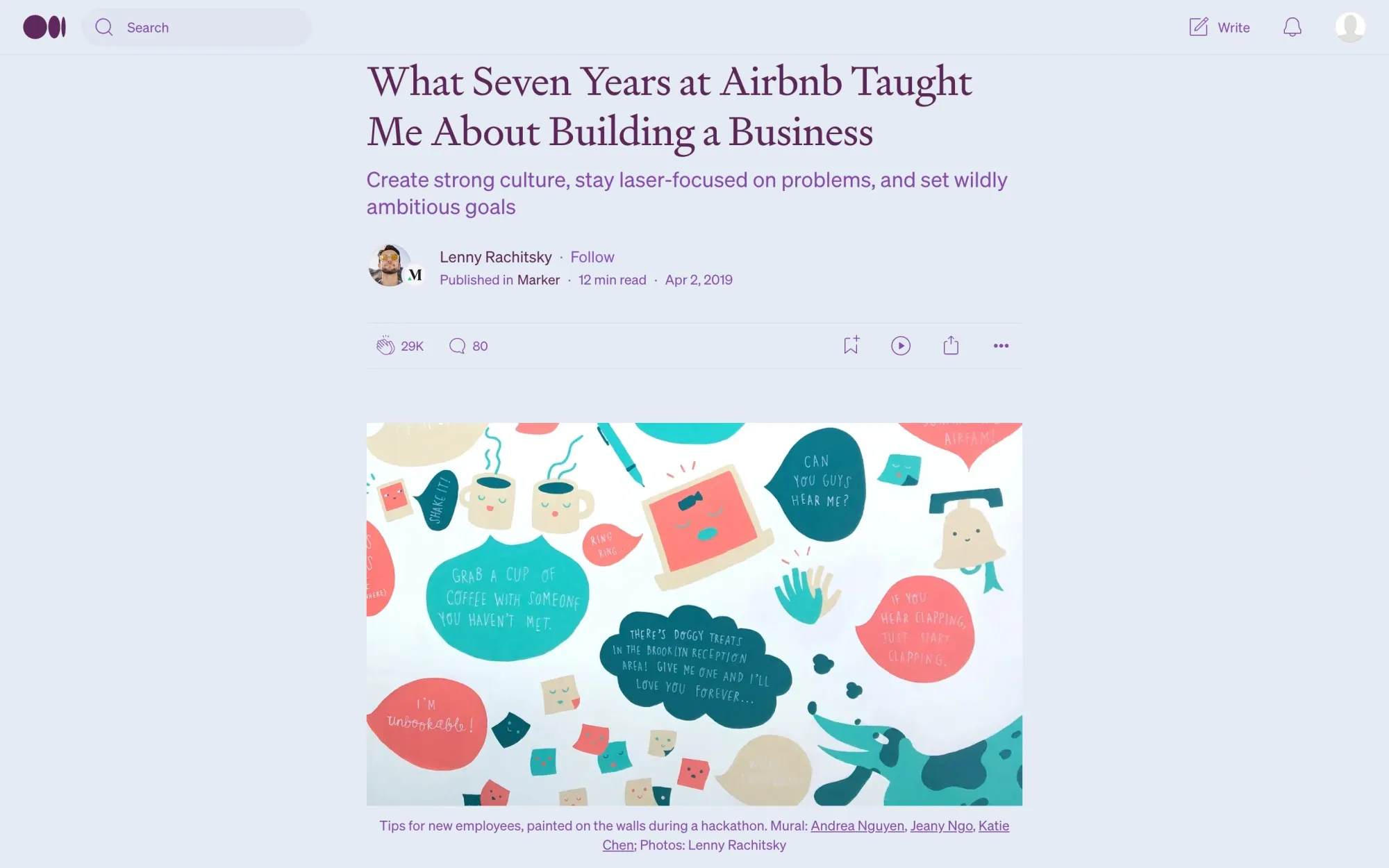
This first, viral article is hosted on Medium and features a random image related to the content. This is his minimum viable product content. And it looks nothing like his newsletter does today, with its custom visuals, own domain, podcast, social media clips, and guest writers.
If you want to grow anything, it’s easy to think you need what the giants have: Sleek design made in Brooklyn, partnerships with other creators and, of course, a podcast. Startups make this mistake all the time, dropping thousands on pitch deck design before anyone has agreed to hear their pitch (or they, God forbid, have built a product).
Instead, Lenny started (unintentionally) with an MVP: He didn’t build his own website, but used Medium. He inserted pictures he took on his phone instead of hiring an illustrator for custom design. The lesson here is to not overthink your first step!
There’s a ton of value in custom visuals, a network of contributors, and a multimedia strategy. But they’re similar to building dark mode: If nobody wants your product, it won’t make the difference.
Lesson 2: Build for an underserved, growing market
From a recent interview:
David Perell: “If you had told me a few years ago, I’m going to have 500,000 or more subscribers based on writing about product management, I would’ve […] called you crazy.”
Lenny: “I would’ve felt the same.”
Independent writing has a cute warmth to it, but Lenny (knowingly or unknowingly) follows ice-cold business theory. Clayton Christensen’s theory of disruptive innovation is simple:
Incumbents create “sustaining innovations,” which meet most people’s needs okay-ish. The incumbent’s scale advantages mean they’ll generally win against startups. Some people have higher standards the incumbent won’t meet. That’s because their scale makes the opportunity is too small to pursue. Startups can beat the incumbent by meeting that segment’s needs better and then shooting past the incumbent.
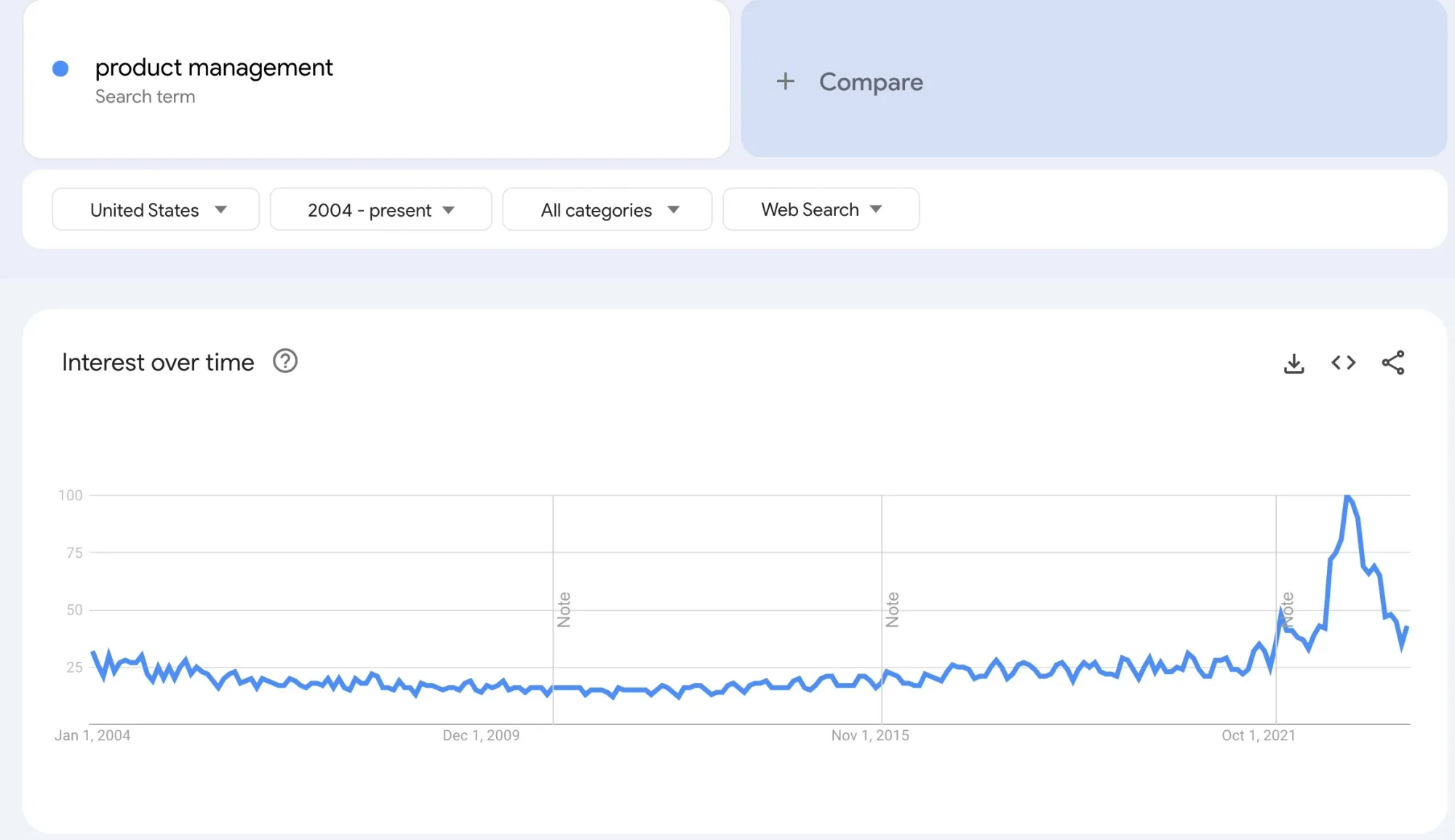
Lenny did exactly this: Today, product management is a trendy profession business school students lust after. When he started, it was an obscure corporate profession.
This obscurity made product managers an underserved market segment in terms of media. The incumbents had some things:
- Occasional blog articles from founders/investors wrote about product management, but nobody was dedicated to the topic with enough quality to meet their needs.
- Books about leadership/entrepreneurship/management would have lessons PMs could apply, but weren’t focused on them.
- Legacy media like Forbes, the Wall Street Journal, or Fast Company might have a useful article, but are too big to care about product managers specifically.
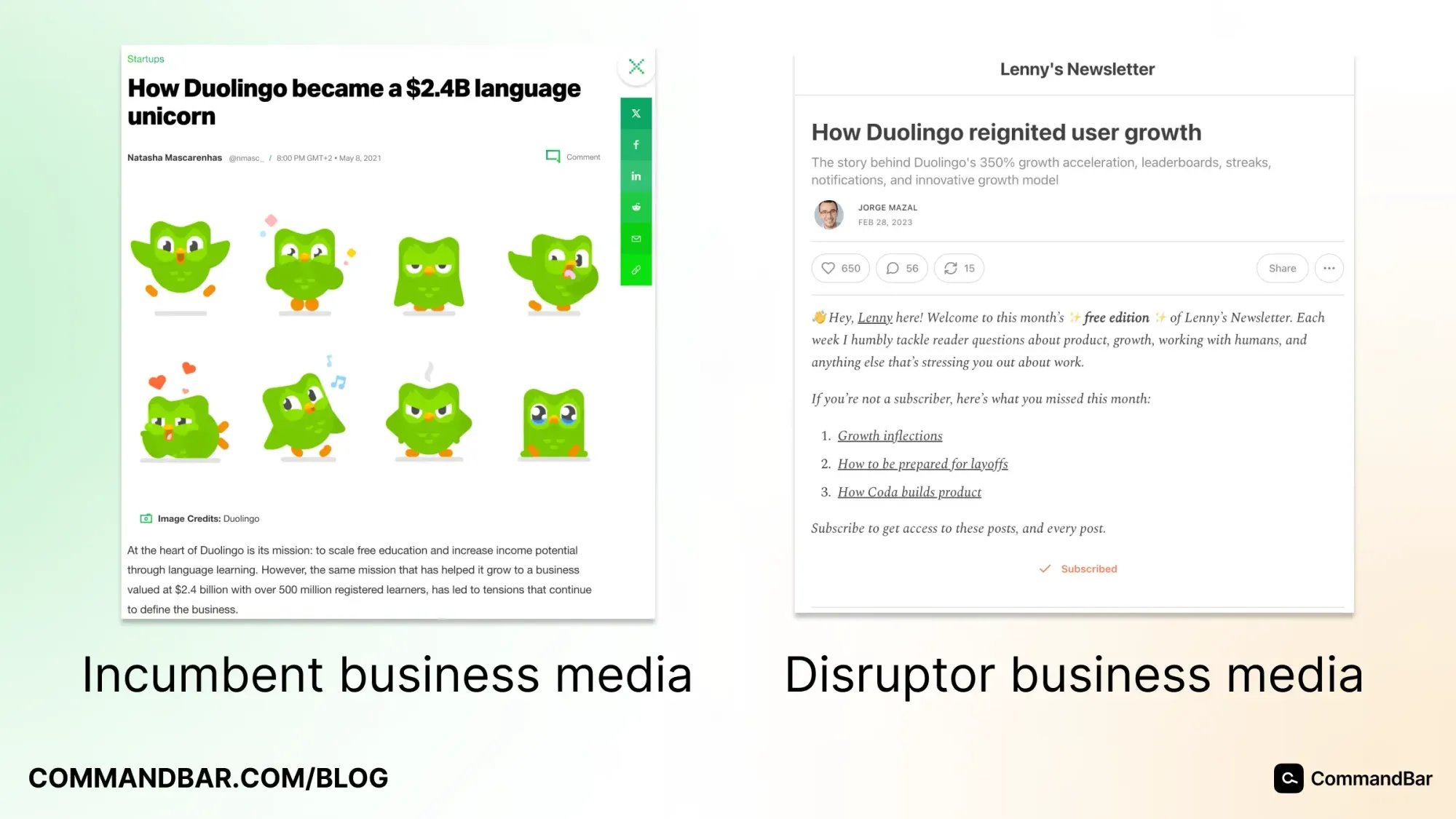
The product manager’s (profession-relevant) media diet was the exact type of suboptimal solution Clayton Christensen bemoans, making it vulnerable to disruption.
Enter Lenny Rachitsky.
He created a publication specifically for this underserved market segment and met their needs better than any previous solution.
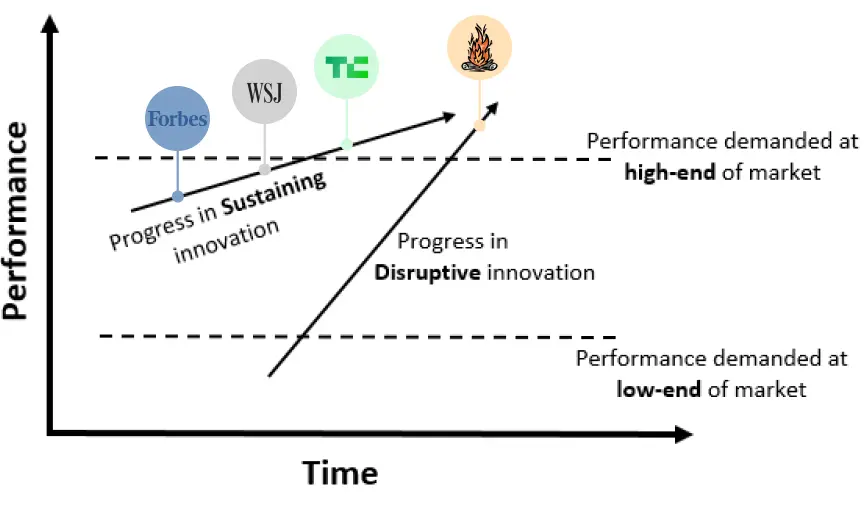
This distinguishes Lenny from other tech writers like Stratechery’s Ben Thompson, who expertly covers technology companies and their products, but doesn’t write for a specific job title. This is a consequence of a changing media environment. In 2013 (the year Stratechery started), being independent was enough of a differentiator. In 2024, everyone has a Substack, requiring deeper differentiation from new entrants like Lenny.
Lenny’s newsletter was disruptive innovation for product management content. It’s how Lenny found product-market fit.
Now, Lenny’s isn’t a SaaS business. And that creates a different challenge:
Lesson 2.2: Keep meeting their needs with a good product
Once you’ve built a product that serves your initial segment, you need to keep delivering. SaaS puts this mostly on autopilot: Keep paying your bills, avoid outages and you’re good (I know this is simplistic, but directionally correct). You write the code once and keep charging for access.
The opposite is true in media. Your customers (aka subscribers) expect new content frequently (usually daily or weekly). You can’t write 100 articles and sell access to your archives.
That’s why this part—keep meeting the needs of the segment you identified—is important in media. In software, products often degrade over years, but users don’t revolt if a week goes by without new features.
That’s why, in every podcast I listened to, Lenny gives the advice of “Quality and consistency.” This is frustrating advice because it’s obvious, but hard to put into practice.

Lenny is great at it and has shipped high-quality content every week for years. In fact, the biggest complaint I’ve heard from paid subscribers is that they wish they could read it all.
This also shows Lenny understands the jobs to be done of his newsletter: One being to help people grow their career by improving at their jobs—two being to provide novelty to talk about.
Lenny himself has written about this. He’s described his newsletter’s JTBD as:
My newsletter’s job-to-be-done is to help you get better at work—specifically, building and growing your product and career. If I can do this job super-well for you, consistently, you’ll keep reading.
This might sound obvious, but is hard to consistently practice. Creatives like writers and designers often toy with new ideas instead of continuing to deliver the product they’ve delivered so far.
At the same time, many people create every week without ever seeing the multi-million dollar upside Lenny does. As a good product person, he knows about good strategy. And strategy starts with advantages.
Lesson 3: Leverage your advantage
If you could summon all the wise elders of product strategy, they’d all agree on one thing: You need to start with your strenghts.
Some strategy books call this finding your “power,” something other product’s don’t/won’t have and thus can be your advantage over them.
But most examples are of giant companies (e.g. Netflix vs. Blockbuster), not independent writers. But if you’ve been a product lead at Airbnb, you know it applies to one-person competition as much as it does to corporate squabbles:
Initial differentiation
Lenny’s first Medium article “What Seven Years at Airbnb Taught me About Building a Business” went viral. The lessons teased in the sub-headline were good, but nothing groundbreaking Create strong culture, stay laser-focused on problems, and set ambitious goals…
I want to acknowledge survivorship bias here: Virality is mostly luck—and it’s likely that Medium contains a graveyard of articles from former Microsoft, Netflix, Apple etc. employees.
But while you can’t predict virality, it’s easy to (almost) guarantee failure: Would an article titled “5 lessons on how to build a big business” have received anywhere near the attention?
Tech startups are often told to highlight differentiation—what makes their product unique.
Lenny’s article was differentiated: Its “secret ingredient” were 7 years at AirBnB. Few people have that experience, turning it into an advantage he could use to stand out.
Doing research others can’t/won’t do
Lenny’s Newsletter began during a sabbatical. That enabled Lenny to write full time, which he has acknowledged as a major advantage over nights-and-weekends writers.
That positioned Lenny to create in-depth content. It brimmed with research and surfaced data others would find hard to come by: While Lenny’s newsletter was still relatively small (around 2-3k subscribers), he wrote an in-depth newsletter about the start and growth of 17 marketplaces, based on dozens of interviews with founders and early employees. Look at the acknowledgments of a post on B2B product-market fit:
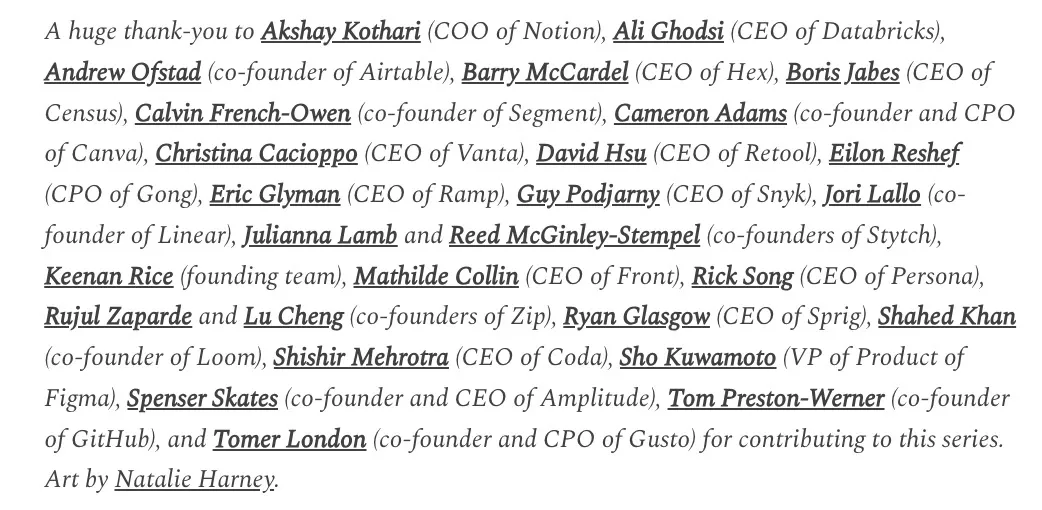
If you’re working a full-time PM job, you don’t have the time to even find these people, let alone interview them all. That way, being full time deepened Lenny’s moat because he could produce more in-depth content than anyone else.
There’s an important lesson in what Lenny didn’t do here: He could’ve learned the wrong lesson and kept writing about his time at Airbnb every week. But that’d be betting on the wrong advantage—one he doesn’t have anymore.
But being a full-time newsletter writer isn’t the only way to be successful. If you were a PM at a big tech company, you could succeed with a uniquely tactical perspective based on your day-to-day work.
But Lenny took the advantage he had (more time than anyone else) and leveraged it to the fullest. That’s good product strategy.
Leveraging his reach
Finally, Lenny started leveraging his reach to create content nobody else could create. The more Twitter followers and Substack subscribers you gain, the more access you have. This shows in Lenny running surveys and turning those into proprietary data:

It would take most people forever to get 1,000 people in a specific profession at specific types of companies to fill out a survey. With hundreds of thousands of followers, Lenny can do this with a few social media posts.
Lenny can source this data with a social media post. It would take others forever! This is another great example of Lenny using a competitive advantage.
Expansion
Geoffrey Moore calls the stage after finding initial product-market fit “Crossing the Chasm”. You’re jumping from the early adopters who love your vision (for Lenny: product managers) to a more mainstream market segment (ambitious tech workers)
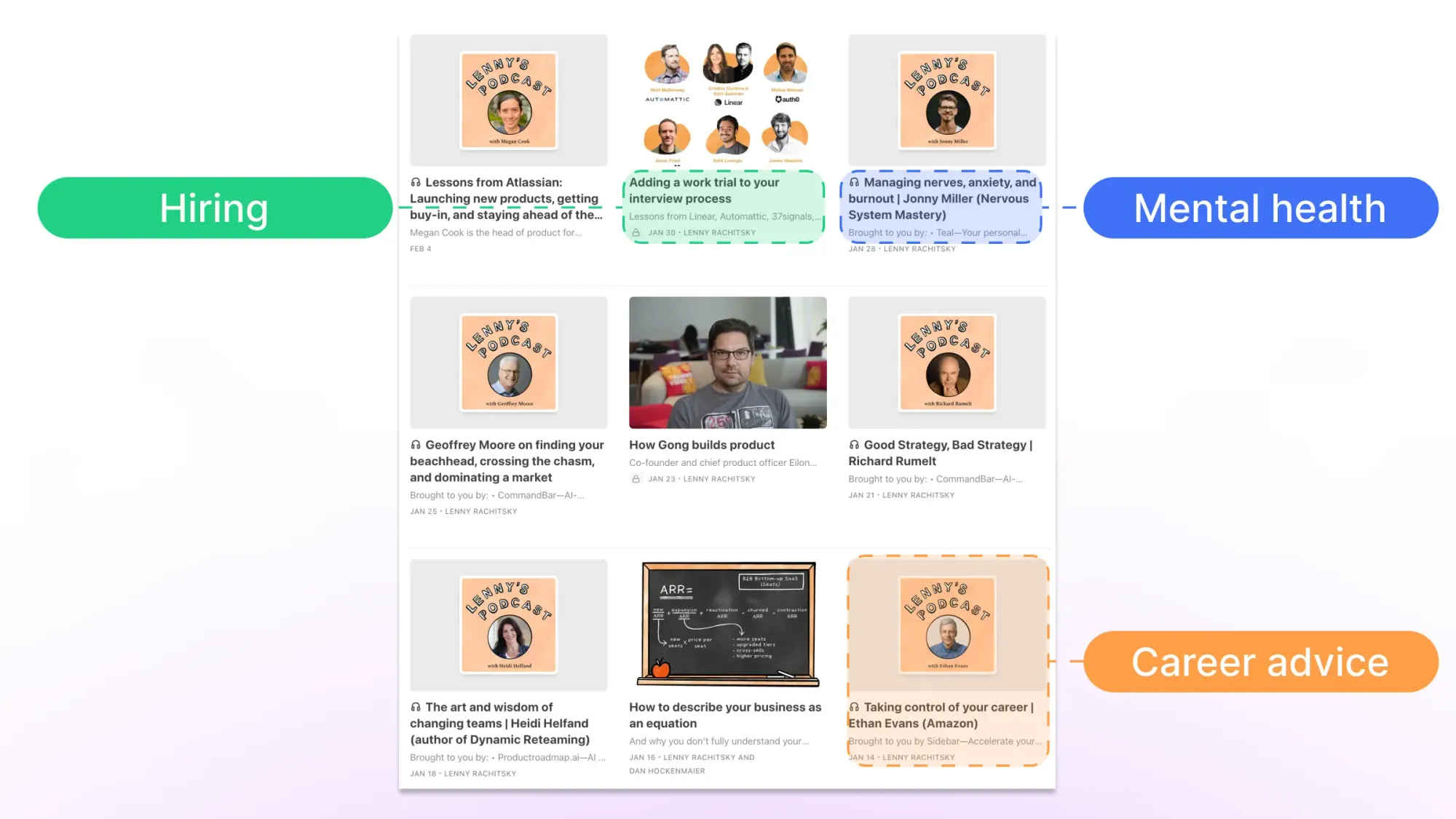
Now comes the growth stage. The same way few startups are satisfied serving the tiny segment they started with, Lenny isn’t satisfied endlessly writing about product management.
3 years ago, all of Lenny’s content was about product management—how to get users, how to grow a variety of metrics. Today, you can find newsletters on salary negotiation, podcasts with engineering managers and even content around combating stress.
There are two aspects (not mutually exclusive) aspects to this:
- The podcast (curiously, going from the written word to audio, just like Amazon did)
- Non-PM topics like engineering management, career advice, mindfulness etc.
These map to two post-PMF growth levers in the startup world:
- The podcast is like adding a second product.
- The topic expansion is like widening your TAM.
These work in tandem. The podcast is a way for Lenny to increase the touchpoints he has with his audience while the topic expansion widens his audience. To put this in SaaS terms, this means he’s both growing his user base and boosting engagement.
Is Lenny really that good at product strategy?
Lacking an interview, my analysis of Lenny is partly mind-reading—which would be great if I actually could. What looks like brilliant product strategy in the rear-view mirror often didn’t come from strategy memos, but resulted from “let’s see what happens.”
I’m sure the same is true of Lenny. He’s a brilliant product manager who has surely internalized many of the concepts I referenced in this article—but has probably stumbled into some of these things.
Yet I find his restraint fascinating. He resisted launching a podcast for long and still seems mindful about his expansion. He’s eschewed many of the obvious things: To date (Feb ‘24), there’s no product management course/coaching. He avoids having VCs and founders on the podcast (even ones with large followings). The team is still just him.
If, as Michael Porter said, the essence of strategy is choosing what not to do, then Lenny is a great product strategist.
In the future: Lenny Rachitsky for X
The success of any product also depends on the macro environment of its industry: The iPod was a massive success when it launched in 2001, but it’d fail miserably today.
Like every successful product, Lenny, too exists in a favorable macro-environment. One factor is the rising popularity of product management, which I mentioned above.
But there’s another factors helping Lenny succeed: The New Yorker sends journalists to the front lines in Ukraine. Lenny types from his bedroom. The New Yorker costs $130 per year, Lenny’s $150.
Lenny commands that premium because his newsletter is essentially a B2B offering. Where you might read a New Yorker profile for entertainment, you read Lenny’s to take action. If that action gets you a raise, promotion or better job, the $150 is a drop in the bucket.
This is becoming more and more common: A practitioner creates in-depth content for a small niche, who is in turn happy to pay a premium to advance their career. This insight has even spawned a new type of company: Turpentine.

Partnering with best-in-their-field practitioners, Erik Torenberg’s new company has launched podcasts specifically for CFOs, limited partners and HR professionals. He’s publicly called the thesis for Turpentine “Lenny Rachitsky for x”.
Epilogue: What’s next for Lenny?
In the software world, the product playbook would continue. Lenny would grow his team, expand to more channels and find more monetization avenues, maybe even start playing with acquisitions and eventually eye an IPO.
Yet this might be where the SaaS product strategy analogy starts to fail us in analyzing the product of Lenny.

A one-person newsletter business has no investors looking for a return and no IPO to look forward to. There’s no board of directors mandating higher revenue. That doesn’t mean Lenny can’t/won’t expand further, hire a team and build a giant media corporation.
But it does mean that this depends on a weirdly pedestrian thing: If he wants to do it.
